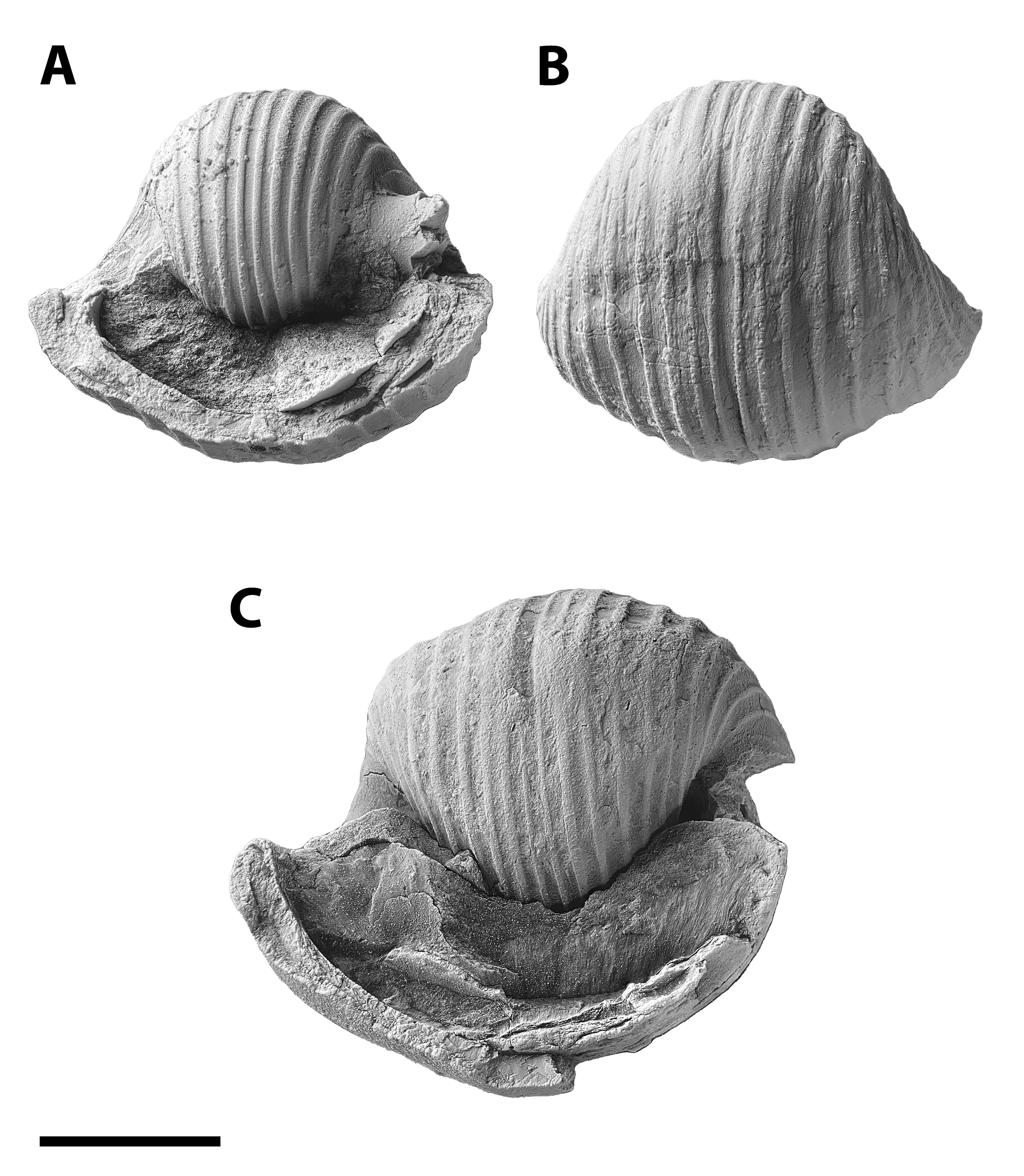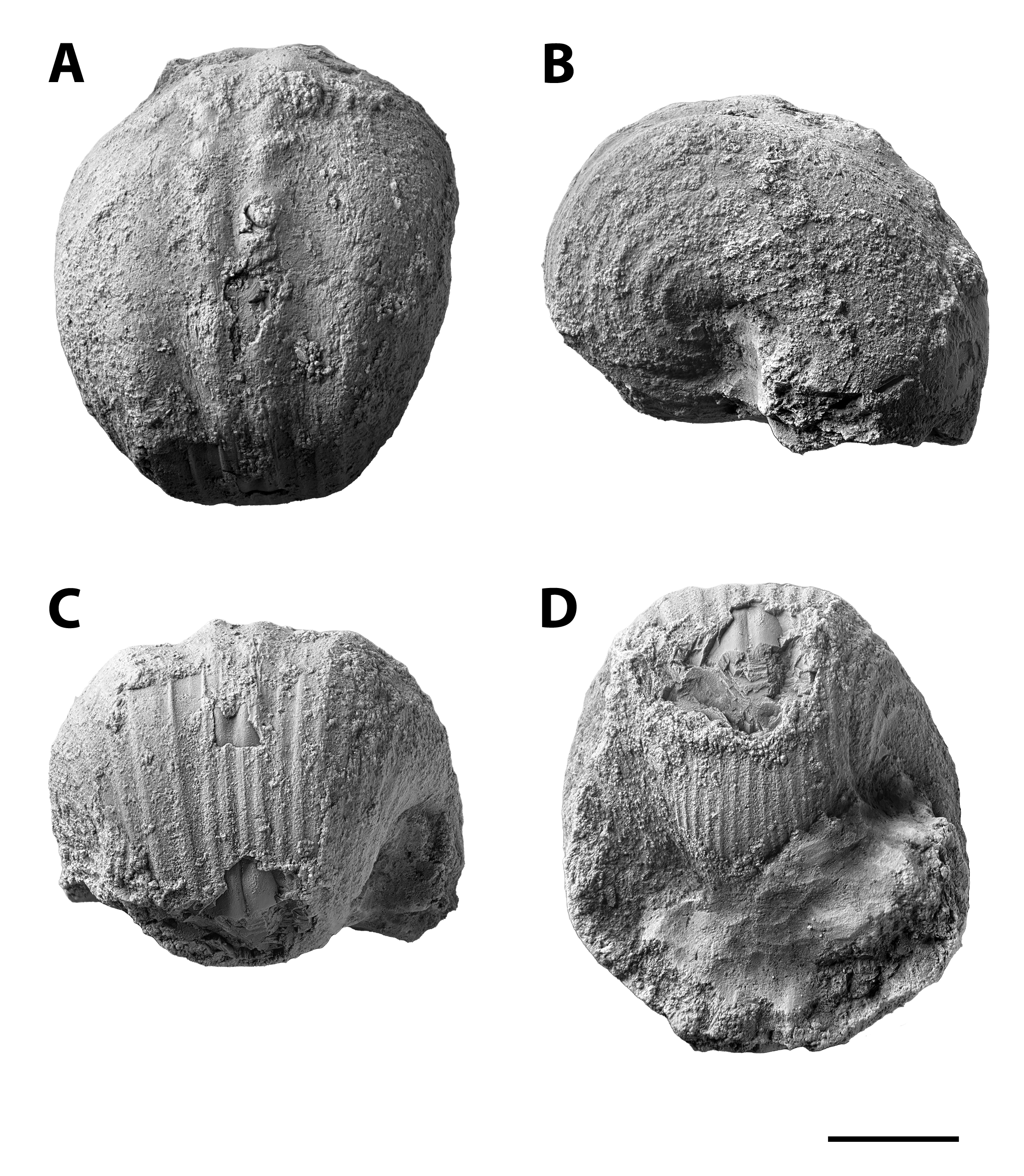Subclass Amphigastropoda Simroth, 1906
Order Bellerophontida McCoy, 1852
Subfamily Euphemitidae Knight, 1956
Genus Euphemites Warthin, 1930
Euphemites are distinct, with their coarse spiral ornamentation visible on the outer shell. Moore (1941) well-illustrated the internal shell structure of Euphemites in a series of figures (see Moore 1941, figs. 1–4) as part of a study on Pennsylvanian gastropods from Kansas. One non-obvious feature to a casual observer of these fossilized shells is that the spiral ornament on the surface instead forms on the inductra, the inside shell layer in the aperture. There are various theories on how this occurs, but none are accepted. No living Bellerophonts exist today.
This genus is ubiquitous in the shale at the Pine Creek limestone locality. Unfortunately, most specimens from the Pine Creek limestone are tiny. I have only recovered one example from the Brush Creek limestone in Parks Township; it has an enormous and thick shell.
Euphemites Plate

Genus Euphemites Warthin, 1930
Species nodocarinatus (Hall, 1858)
The gastropod Bellerophon nodocarinatus (=Euphemites nodocarinatus) was named by Hall in 1858 in a geological report of Iowa. The name means knotty/lumpy kneels (or carina), characterized by the dual lumpy ridges visible from the anterior margin across the shell. Members of Euphemites have spiral lirae that appear in the aperture and extend toward the anterior margin. The whorl width expands as the shell enlarges. Research of the shell layers (Moore, 1941) has shown that the creature added the spiral lirae to the shell after primary growth, likely with modification of the original nodose carina feature.
Hall was reporting on fossils from upper and lower coal measures without distinction. He noted that the reported fossils are common in Western Pennsylvania and elsewhere.
Euphemites nodocarinatus Plate

References
- Knight, J.B., 1956, New families of Gastropoda. Journal of the Washington Academy of Sciences 46(2), p. 41–42
- Hall., J., 1858. Palaeontology of Iowa. Report of the Geological Survey of the state of Iowa 1(2):473-724 [plate]
- Moore, R. C., 1941. Upper Pennsylvanian gastropods from Kansas. State Geological Survey of Kansas Bulletin 38(4):121-162
- Sedgwick, A., McCoy, F, 1850-1855, A synopsis of the classification of the British Palæozoic rocks; With a systematic description of the British Palæozoic fossils in the Geological museum of the University of Cambridge.
- Simroth, H. (1906). Versuch einer neuen Deutung der Bellerophontiden. Sitzungsberichte Der Naturforschenden Gesellschaft Zu Leipzig, 32: 3–8.
- Warthin, A. S., Jr. 1930. Micropaleontology of the Wetumka, Wewoka, and Holdenville formations. Oklahoma Geological Survey Bulletin 53:1-94

Late Carboniferous Fossils from the Glenshaw Formation in Armstrong County, Pennsylvania
Preface | The Photographic Process
Localities: Locality SL 6445 Brush Creek limestone | Locality SL 6533 Pine Creek limestone
Bivalvia: Allopinna | Parallelodon | Septimyalina
Cephalopoda: Metacoceras | Poterioceras | Pseudorthoceras | Solenochilus
Gastropoda: Amphiscapha | Bellerophon | Cymatospira | Euphemites | Glabrocingulum | Meekospira | Orthonychia | Patellilabia | Pharkidonotus | Retispira | Shansiella | Strobeus | Trepospira | Worthenia
Brachiopoda: Cancrinella | Composita | Isogramma | Linoproductus | Neospirifer | Parajuresania | Pulchratia
